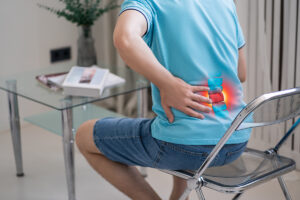How Do They Happen? What Are the Symptoms of a Bulging Disc? How Are They Diagnosed and Treated?
 You’ve been in an automobile accident caused by someone else’s negligence, and you’re experiencing numbness or tingling in your lower extremities. Or maybe you have pain or stiffness when sitting, walking, or trying to move. It’s possible that you’ve suffered trauma to the discs that cushion the vertebrae in your back. You may have a bulging or herniated disc.
You’ve been in an automobile accident caused by someone else’s negligence, and you’re experiencing numbness or tingling in your lower extremities. Or maybe you have pain or stiffness when sitting, walking, or trying to move. It’s possible that you’ve suffered trauma to the discs that cushion the vertebrae in your back. You may have a bulging or herniated disc.
What Is a Bulging or Herniated Disc?
There are 33 small bones–your vertebrae–that make up your spinal cord. Between each of them is a soft cushion, or disc, that helps absorb shock, keeping your vertebrae from rubbing against each other when you move or experience any type of impact. Each disc has a firm, but pliable outer wall that allows the disc to retain its shape and absorption.
How Can a Car Accident Cause a Herniated or Bulging disc?
With either a herniated or bulging disc, the integrity of the outer wall of the disc has been compromised. A herniated disc involves a tear or hole in the outer wall, which allows some of the jelly-like substance inside the disc to escape into the spinal canal. With a bulging disc, the outer wall of the disc may become thin, allowing the fluid to “bulge” out, much like a balloon. There is, however, no break in the outer wall.
When you are involved in a motor vehicle accident, your spine may violently snap back and forth or make impact with a foreign object. Either situation can easily cause a tear. The accident can also cause substantial twisting or torque on your spine that stretches the outer walls of a disc, making you susceptible to a bulging disc.
Signs That You Have a Bulging or Herniated Disc
When you suffer a herniated a bulging disc, the nerves throughout your spinal cord may have less protection and may be subject to greater pressure. That can lead to:
- Pain or discomfort in your lower body, including your feet, legs, calves, thighs, and buttocks
- Tingling anywhere in your body, including your upper extremities
- Difficulty walking, bending, sitting, squatting, or crouching without pain
How Will Your Doctor Diagnose and Treat a Herniated or Bulging Disc?
Your physician will typically start with a full medical exam, focusing on your back. In most instances, you’ll be asked to lie on your back and move your arms and legs in different ways. Your doctor is checking for muscle strength, reflexes, and sense of touch. Though X-rays won’t indicate whether you’ve suffered a disc injury, there are other tests, such as MRIs, CT scans, and myelograms, that can help.
Your doctor can typically prescribe medication to address pain and inflammation, and to help your muscles relax. Physical therapy is also commonly used to address disc problems, helping you build strength in the muscles that support your back and spine.

